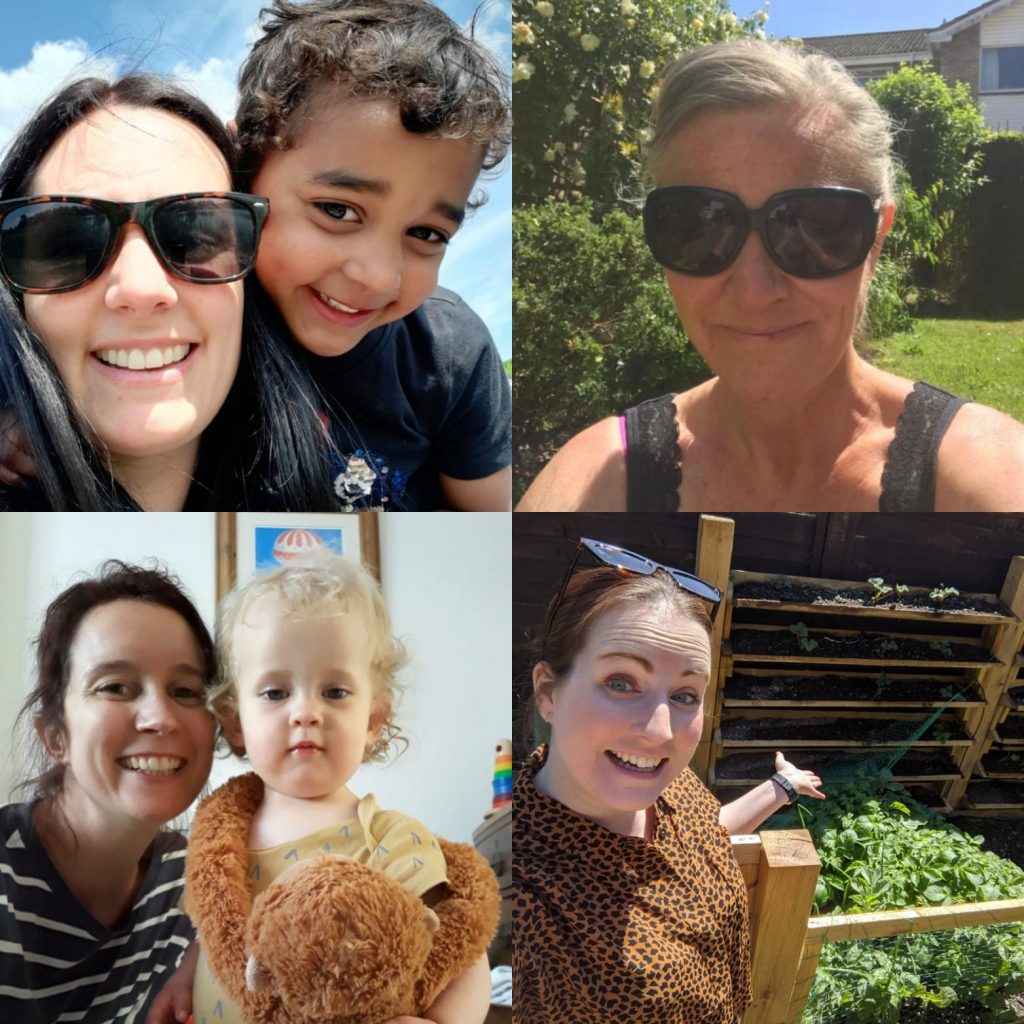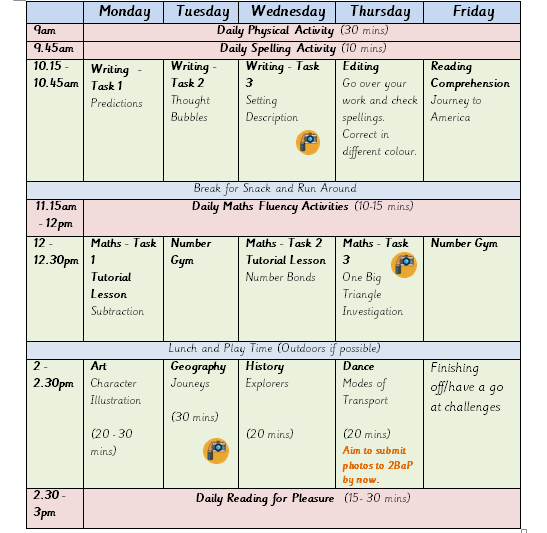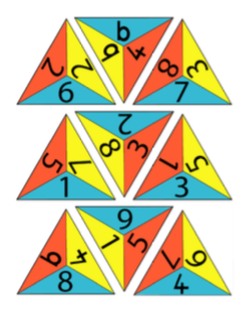Hope you all had a fantastic Half Term break and enjoyed some outside time in the sun.

Thanks to all of you who managed to send some of your wonderful learning to your profile once again before half term. You are producing some amazing things and it looks like you’re having lots of fun in the process.
This week, we are going to start on our new topic of Journeys, a topic that the whole school will be working on together. This term KS1 planning will be much more closely aligned. If you also have a child in Year 1 you will notice that the tasks are often the same, just slightly differentiated to suit the different year groups.
Below again is a summary of this week’s learning to act as guidance only and not a strict timetable to follow. Please work with the routines that suit your family best. The timetable shows the three pieces we would like you to photograph and submit into your 2 Build a Profile platform so that we can celebrate the work and give some more feedback. Remember that other pieces are welcome to, especially things that you are really proud of. Please remember to send any photos of written work to your class email as well.
This week’s resources, including a copy of the timetable, are here. More specific links are available throughout the plans.

Reading
Learning objective: Identify the main events and characters in stories, and find specific information in simple texts.
Carry on reading the books you are enjoying at home or pick some new online books to read on ‘Bug Club’. This week, focus is on the main events in a story and identifying the role and journey of the main character. In your chosen book think about and discuss, with an adult where possible, about the main events in the story, have a go at using the story sequencing sheet in the English folder and map out each event in the boxes provided. Label each picture with a caption to indicate the event.
Have a go at completing this reading comprehension about going on a journey to America.
Spelling
This term we will be having a particular focus on spelling. We will start with the Year 2 Common Exception Words. There is a spelling workbook to have a go at, we recommend doing a little each day rather than all in one go! Try and focus on spelling these words accurately in your writing this week, it is OK to have the word list in front of you to help. Once you have completed all your writing tasks go back and check that you have spelled the words correctly. You can edit the ones you need to correct with a different colour pen like we do in school.
Writing
This week, we are very excited to introduce our new key text for our whole school topic: ‘Journey’ by Aaron Becker. It is a wordless book about an ordinary girl who draws a magic door on her bedroom wall! A journey of magic and adventure follows.
Task 1: Predictions
Learning Objective: To use the information on a front cover and past experiences to help make predictions about a story, setting and characters.

Look carefully at the front cover of our new key text. What do you predict will happen in the story? Who is the character in the boat? Where is it set? Think, discuss and record your predictions and we will see if you were right later on! You could record your ideas in a list, a mind map or even ask a grown up to record what you think.
Task 2: Thought Bubbles
Learning Objectives: 1. Use information from an illustration to think about the feelings and thoughts of characters in a story.
2. Write sentences in a thought bubble. Connect to how speech may be written.
Watch Mrs Fricker’s video of the start of the story. You will notice that it has no written words!! Now look at the first picture in the book more closely. What is going on in the house and outside? What would be in each thought bubble for each person? You can write them in your book if you don’t want to print off the sheet.
Challenge: Write a diary entry for that day from the viewpoint of one of the characters.
Task 3: Setting Description
Learning Objective: 1. Write a setting description connected to your own illustration.
2. Use ideas from other stories and experiences to create an image connected to a story.
Imagine that you had a pen that could be used to draw and create a magic door like the girl from our story. What would your door look like? Where would it take you? Draw a picture of your door and then a picture of the place you would end up in when you go through it. Is it magical, squishy, strange, mysterious? You may have images from other books in your mind that you want to use or just pictures from your imagination! Write a setting description of the land beyond your magic door. Remember to use those expanded noun phrases to really paint a picture in the mind of the reader. Send a copy of your pictures and your writing to your profile and your class email.
Maths
Lessons 1 and 2 will use instructions from a video tutorial. Please be aware that you will need to click back on the Summer Term Week 4 (w/c 11th May) tab, to find the correct tutorials. Before commencing the video ensure that your child has everything they need, including:
- the correct ‘Flashback4’ sheet (to be completed before the tutorial starts);
- the question worksheet (the answer sheet is also available for marking);
- a pencil;
- a workbook or piece of paper to work on.
- Resources for counting (a printable 100 square and base 10 are available here).
The tutorial will ask your child to pause the video at certain points. Please ensure that they know how to do this if you are not able to sit with them. The question sheet should be completed after the tutorial (please note these are accessed through these plans and can no longer be clicked on next to the tutorial).
Daily Fluency: For tasks 1 and 2, the Flashback 4 sheet should be completed before the tutorial. Three additional fluency tasks are available here. This week, these will focus on adding 10s.
Task 1 – Subtraction Tutorial
Learning Objective: Subtract and two 2-digit numbers using an efficient strategy.
Set up the video tutorial . Remember to click on the Summer Term Week 4 (w/c 11th May) tab and scroll to Lesson 3 – Subtract Two-Digit Numbers.
You will need the Flashback4 Fluency Sheet, the worksheet and the Base 10 resources (if required). Please go through the answers with your child after they have completed the tutorial.
Reduced Challenge: If your child has difficulty following the tutorial, please revise subtraction using this tutorial instead. Scroll to Week 4, Lesson 2 – Subtract within 20. The worksheet is available here.
Extension: Try the ‘Diving into Mastery’ challenges. There are three levels of challenge here; try the simplest level and move on only if the level of challenge is appropriate.
Task 2 – Number Bonds
Learning Objective: Recall number bonds to 10 and and use these to calculate and reason with bonds to 100.
Set up the video tutorial. Remember to click on the Summer Term Week 4 (w/c 11th May) tab and scroll to Lesson 4 – Bonds to 100.
You will need the Flashback4 Fluency Sheet and the worksheet. Please go through the answers with your child after they have completed the tutorial.
Reduced Challenge: If your child has difficulty following the tutorial, please revise subtraction using this tutorial instead. Scroll to Week 4, Lesson 3 – Add and Subtract Problems. The worksheet is available here.
Extension: Try the ‘Diving into Mastery’ challenges. There are three levels of challenge here; try the simplest level and move on only if the level of challenge is appropriate.
Task 3: One Big Triangle
Learning Objective: Recall number bonds to 10 and use them in reasoning activities.
In this challenge, there are 9 triangles. Each has 3 numbers.

The challenge is to arrange them into one big triangle, so that the numbers that touch add up to 10.
The triangles to cut are available here.
If your child would prefer triangles with 10s frames then they can be accessed here.
Please support your child’s thought process by discussing their plan and what they might do next as they tackle the problem. We would love to see photos of children working on this task.
Reduced Challenge: Use the triangles like dominoes (still matching to make 10) and see what shapes you come up with.
Extension Challenge: Children could be asked whether they can find more than one solution. How will they know whether another solution is the same or different to any they have already got? How will they know that they have found all the solutions?
Learners could also use the cards to make a shape (not necessarily a triangle) where the touching numbers add to 9 (or 8 or 11). Alternatively, they could add their own choice of numbers to these blank triangles to create their own activity.
PE
Fitness: Please continue to start your day with Joe Wicks or something similar, you are aiming for around 20 mins to 30 mins with a warm up and cool down.
Dance
Lesson Objective: Develop strength, flexibility, control and balance when moving.
Create a (clear) route in the garden or reasonable sized room. Children move around the route in the manner of a mode of transport. They must complete the entire route as each mode of transport before they can move on to the next. Using the suggested playlist (or your own) stop the music randomly; the child must hold a pose – any movement or wobbling and it’s back to the beginning of the route!
- Plane
- Surfboard
- Steam train
- Motorbike
- Horseback
- Rocket
- Canoe
- Scooter
- Skis
- Tightrope
Suggested playlist: Queen: Don’t stop me now, Cliff Richard: Summer Holiday, Moana: How far I’ll go, Proclaimers: I’m gonna be, Fiddler’s Dram: Day trip to Bangor.
Geography
Learning Objective: Plan a journey, considering distance and appropriate transport and equipment.
Look at the My Special Journey PowerPoint. Children will plan their own journey, deciding where they want to go, discuss why they want to visit that place. How will you get there? Children need to pick an appropriate mode of transport to get there thinking about logistics (e.g. you can’t go to the bottom of the ocean on a train). What will you need to take? Decide on 5 things you will take with you.
Complete the Geography Journey sheet.
Challenge: Write a complete sentence about the transport they will use to get there and give a reason why they chose it e.g. I would fly in a plane because it is a long way. Finally draw a picture of the five things they would take with them in the suitcase.
Art
Learning Objective: Create an illustration using line, shape, form and space.
Look at the different characters in the story. Can you create your own illustrations of them? This video has some tips from the author/illustrator:
History
Learning Objective: Research the lives of significant individuals from the past.
Discuss what the children understand by the word ‘explore’. Have they ever explored anywhere themselves? Use the Explorers PowerPoint (or your preferred resource such as google, an encyclopedia or specialist book) to find out about famous journeys, explorers and expeditions from history. Pick two or three examples to read. Challenge: do some research into your own explorer. There are more suggestions in the presentation.
Use what you have discovered to create a fact file about an explorer you found interesting (there is a fact file template or feel free to create your own). Draw a picture of the explorer and write their name at the top. Include information such as where they were from, when the expedition or journey took place, where did the expedition or journey happen, what mode of transport was used or an interesting fact.
We would like to see photos of your fact files on 2BuildaProfile (and please email them as well).
